Community Embraces New Word Game at Mid-Year Play Day This past Sunday, families at Takoma Park’s Seventh Annual Mid-Year Play Day had the opportunity to experience OtherWordly for the first time. Our educational language game drew curious children and parents to our table throughout the afternoon. Words in Space Several children gathered around our iPads […]
Read moreTag: museum
 The Grand Canyon is yet another place that Google brings to your digital screens, from their Street View family of content. Google has been collecting street-level views of our world at a vast scale possible only because of it’s deep pockets and technical expertise. (more…)
The Grand Canyon is yet another place that Google brings to your digital screens, from their Street View family of content. Google has been collecting street-level views of our world at a vast scale possible only because of it’s deep pockets and technical expertise. (more…)
 Over 30,000 objects are now available for anyone to savor and study online, for free, in impressive high resolution, in Google’s ‘Art Project.” This is 30x expansion from the thousand objects in the first version launched in February 2011. See our prior article, The virtual vs. the real: Giga-resolution in Google Art Project. The project now has 151 partners in 40 countries; in the U.S., the initial four museums has grown to 29 institutions, including the White House and some university art galleries.
Over 30,000 objects are now available for anyone to savor and study online, for free, in impressive high resolution, in Google’s ‘Art Project.” This is 30x expansion from the thousand objects in the first version launched in February 2011. See our prior article, The virtual vs. the real: Giga-resolution in Google Art Project. The project now has 151 partners in 40 countries; in the U.S., the initial four museums has grown to 29 institutions, including the White House and some university art galleries.
See the site: Google Art Project (more…)
Online courses can be a great way to teach (and learn) new skills. They can be small and highly personal, or scale to thousands of students. As followup to my post about “What is an online course?”, let’s look behind the scenes at a few kinds of successful online classes, rich with video, feedback and large amounts of real-world work.
Structuring a course
![]() The Museum of Modern Art (MoMA) currently has six 8 or 10 week online courses. The cost is $200 for self-guided courses, or $350 for instructor-led. The latter enroll 30-45 students. MoMA offers both knowledge classes, e.g., “Modern and Contemporary Art: 1945–1989,” and knowledge/skill courses, e.g., “Materials and Techniques of Postwar Abstract Painting,” in which students do hands-on work at home.
The Museum of Modern Art (MoMA) currently has six 8 or 10 week online courses. The cost is $200 for self-guided courses, or $350 for instructor-led. The latter enroll 30-45 students. MoMA offers both knowledge classes, e.g., “Modern and Contemporary Art: 1945–1989,” and knowledge/skill courses, e.g., “Materials and Techniques of Postwar Abstract Painting,” in which students do hands-on work at home.
The instructor-led classes offer structure, socialization and personalization; whereas, the self-guided courses are about individual freedom, providing access to curated articles and video, with no live instructor facilitation nor social interaction with other students.
 The studio-art offerings have weekly assignments. For example, students paint canvases using the materials and techniques of iconic artists. They photograph their works in progress and finished, and upload them to discuss with other students and the instructor. Wendy Woon directs MoMA’s education department. She feels the 10-week timeframe has worked well for studio art, allowing enough time for a sense of trust and community to develop in the discussion forums so that students are willing to have “critical conversations” criticizing each other’s work.
The studio-art offerings have weekly assignments. For example, students paint canvases using the materials and techniques of iconic artists. They photograph their works in progress and finished, and upload them to discuss with other students and the instructor. Wendy Woon directs MoMA’s education department. She feels the 10-week timeframe has worked well for studio art, allowing enough time for a sense of trust and community to develop in the discussion forums so that students are willing to have “critical conversations” criticizing each other’s work.

“The debate about which is better, face-to-face learning or online learning is fast becoming obsolete,” says Jennifer Berghage, an instructional designer at Pennsylvania State University. The common goal is that “an online course should be, above all, engaging, so that the learner enjoys the learning and is able to not only assimilate it but retain it and apply it.”
Online courses are revolutionizing formal education, and have opened a new genre of outreach on cultural and scientific topics. These courses deliver a series of lessons to a web browser or mobile device, to be conveniently accessed anytime, anyplace. (more…)
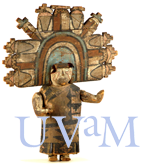 A Hopi doll with painted headdress springs to life, spinning under my finger tips on a new iPad app from the University of Virginia Art Museum (UVaM).
A Hopi doll with painted headdress springs to life, spinning under my finger tips on a new iPad app from the University of Virginia Art Museum (UVaM).
The delightful app presents 19 different objects in 3D, to spin and zoom, providing an immediacy that rivals seeing an object in real life. In fact, it’s better in many ways than peering at an object through a protective case because the objects can be spun through a full 360°, view under bright lighting, at high resolution.
Personal exploration
The free app presents the mobile visitor with a grid of objects (below, left):
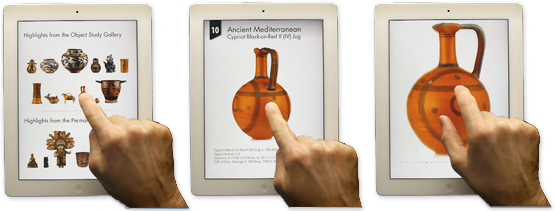
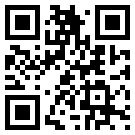 QR codes are a way to send information to mobile devices (e.g., a smartphone) using its camera. You send a short blurb of text, or a web address (URL) by representing it as a code which people photograph from their phone.
QR codes are a way to send information to mobile devices (e.g., a smartphone) using its camera. You send a short blurb of text, or a web address (URL) by representing it as a code which people photograph from their phone.
The codes are easy to generate. Several web sites and software programs will make the codes for you.
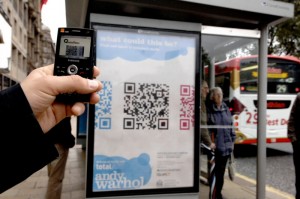 To read the codes, users need a QR reader app to take a snapshot of the code with their device’s camera. The app returns the decoded text or web URL.
To read the codes, users need a QR reader app to take a snapshot of the code with their device’s camera. The app returns the decoded text or web URL.
In the photo at left, a pedestrian takes a photo of a QR code promoting an Andy Warhol show.
There are hundreds of barcode-reader apps (e.g., RedLaser and QuickMark for iOS and Android devices, and the Kaywa reader for dumber smartphones), and code-reading can be included in custom apps, e.g., a museum tour. (more…)
Virtual exhibits on tablet devices (e.g., the Apple iPad) put exhibits at the fingertips of students and the public. Visitors can browse science, art or culture from classrooms, during their commutes, or from their sofas. — But where does the money come from?
As with physical museums, the problem with charging money for downloads is limiting visitation to enthusiasts. Access must free to get significant use on tablet computers in classrooms, or by people who would not otherwise pay. Aside from grant support or advertisements, are there other revenue models? Could funding come from the community?
We posit that virtual exhibit apps could be free downloads, giving a preview teaser. Then, to see the rest of the exhibit, visitors pay for access, sponsor access for others, or request free access. Here’s how it might look: (more…)
 There is no better way to reach underserved audiences than to drive directly to them. Mobile museums, in converted RVs or semi-trailers, are delivering history, science and art experiences. Here are two great examples.
There is no better way to reach underserved audiences than to drive directly to them. Mobile museums, in converted RVs or semi-trailers, are delivering history, science and art experiences. Here are two great examples.
History
Reaching rural audiences for $10.71 per visitor, the “Van of Enchantment” brings cultural history to schools and public events in New Mexico — at no cost to visitors. New Mexico’s rich history traces back at least 11,000 years, and includes a flourishing Pueblo community in the 13th century, Spanish conquistadors and colonists in the 16th century, and railroads in the late 19th century. (more…)


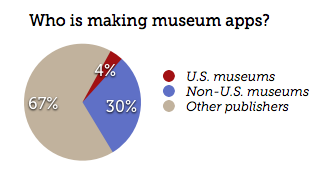 The vast majority of museums are totally ignoring mobile apps.
The vast majority of museums are totally ignoring mobile apps.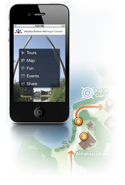 It is getting easier and cheaper for cultural and scientific organizations make mobile, handheld tours. According to
It is getting easier and cheaper for cultural and scientific organizations make mobile, handheld tours. According to 